한국인에게 가장 전통이 잘 보존된 도시가 어디냐 물어본다면 전북 전주(全州)라 답하는 이들이 적지 않을 것이다. 그도 그럴 것이 한국 특유의 목조건물인 한옥(韓屋)이 유독 많은 도시가 전주다. 하지만 전주는 과거 전통에만 안주하는 도시가 아니다. 잘 보존한 과거 위에 다양한 문화와 혁신을 고루 섞어 비빔밥처럼 잘 비벼진 조화로운 도시다.
When asked which city best preserves their country’s traditions, Koreans often pick Jeonju, a city in North Jeolla Province that boasts many hanok, traditional Korean wooden houses. Much like its eclectic versions of bibimbap, Jeonju offers a delightfully harmonious mix of the well-preserved past and modern culture and innovation.
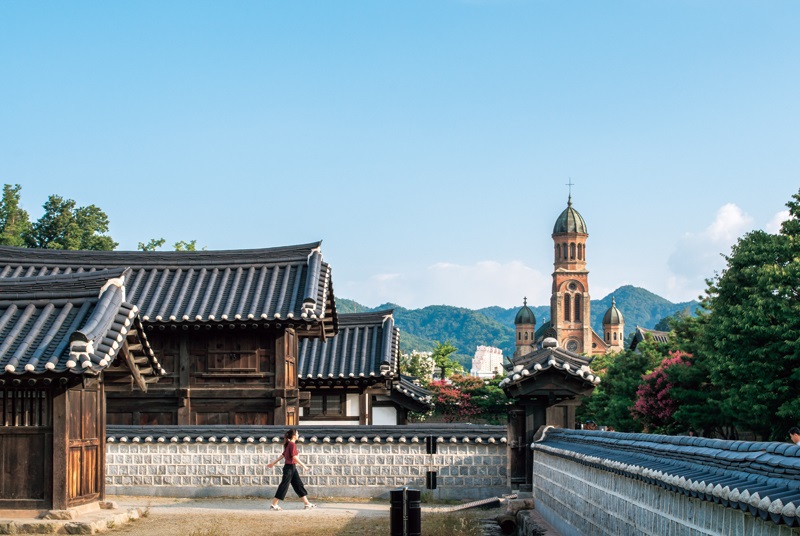
Jeonju, South Korea - August 3 2017: Jeonju Hanok Village and Jeondong Catholic Church. The village containing over 800 Korean traditional houses famous among Koreans and tourists. ⓒ 셔터스톡 - Shutterstock
전주한옥마을 여행의 출발점으로 삼을 만한 곳 중 하난 오목대(梧木臺)다. 야트막한 언덕을 오르면 평평한 대지 위에 정자가 자리 잡고 있다. 전주한옥마을을 한눈에 조망하기에 더없이 훌륭한, 아니 유일한 장소라 할 수 있다. 약 30만 제곱미터에 무려 700채가 넘는 한옥들이 군락을 이루고 있다. 전주가 국내 최대 규모의 전통 한옥마을로 손꼽히는 까닭이다. 촘촘히 박혀 있는 기와지붕들은 마치 검푸른 파도가 밀려오는 듯한 착각마저 들게 한다.
Jeonju’s hanok village is the largest by size in Korea, with more than 700 traditional houses preserved in an area spanning 300,000 square meters. A great place to start a tour is Omokdae, a pavilion atop a steep hill that offers a panoramic view of the entire hanok village. The densely packed tiled roofs give the illusion of surging dark blue waves.
조선왕조의 시작 - DAWN OF THE JOSEON DYNASTY
오목대가 전망대 구실만 하는 것은 아니다. 정자 안에 들어가면 현판들이 걸려 있는데, 그 중< 대풍가(大風歌) >에 그 비밀이 숨겨져 있다.
Yi’s choice of poem has sparked speculation that he effectively revealed his ambition to overthrow the old dynasty and establish a new one, which he would realize around a decade later. His recital at Omokdae can thus be seen as a harbinger of the 472-year-long Joseon Dynasty.
大風起兮雲飛揚 큰바람 일자 구름이 흩날리네. A strong wind scatters the clouds.
威加海內兮歸故鄉 온 천하에 위풍을 떨치고 고향으로 돌아왔노라. I have returned home in glory after a triumphant victory.
安得猛士兮守四方 어떻게 용사를 구해 천하를 지키랴! How can we find warriors to defend our country!
오목대 < 대풍가 >의 주인공은 1392년 조선(朝鮮)을 건국한 태조(太祖) 이성계(李成桂 재위 1392∼1398)다. 고려(高麗) 말 장수였던 그가 왜적의 침입을 물리치고 상경하는 길에 전주에 들러 불렀다는 것이다. 훗날 사람들이 이성계가 전주 오목대에 이르러 옛 왕조를 무너뜨리고 새 왕조를 새로 세울 조짐을 드러냈다고 평가하는 이유다. 즉 조선왕조의 시작점이 전주였다는 것이다.
Omokdae also holds historical significance. Before Yi Seong-gye became the founding king of the Joseon Dynasty (as King Taejo, r. 1392–1398), he served as a general during the late Goryeo period. In September of 1380, despite being heavily outnumbered, Yi led his troops to a decisive victory against waegu, pirates from Japan whose raids had plagued the Korean peninsula. Before his triumphant return to Seoul, he stopped by Jeonju, the ancestral home of his clan, for a celebratory feast, during which he is said to have sung the poem “Song of the Great Wind,” now written on one of the plaques inside the pavilion.
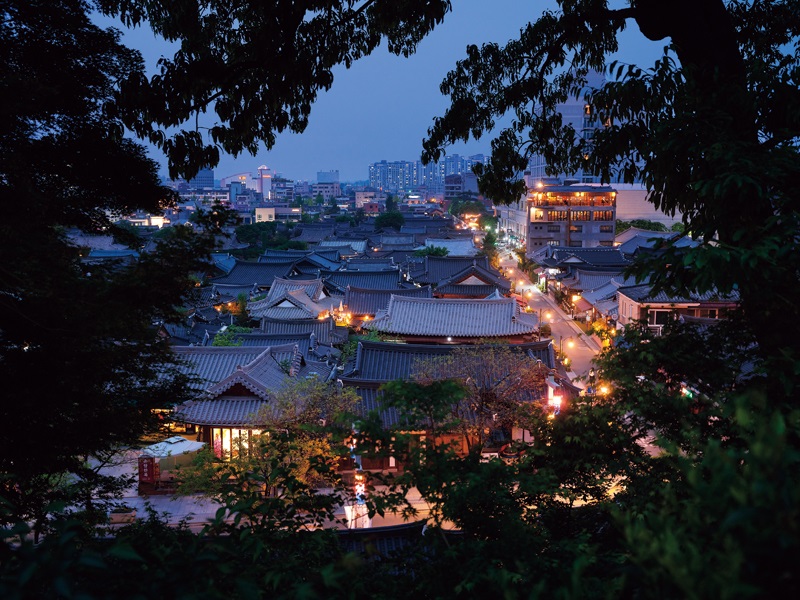
전주 한옥마을은 서울 북촌한옥마을과 함께 대표적인 한옥보존지구이다. 오목대에서 한옥마을을내려다보면 빼곡한 기와지붕이 마치 검푸른 파도가 밀려오는 듯한 모습이다. Along with Bukchon Hanok Village in Seoul, Jeonju Hanok Village is an important area preserving traditional Korean houses. When looking down from Omokdae, its densely packed tiled roofs give the illusion of surging waves.
조선왕조와 전주의 연결고리는 오목대만이 아니다. 한옥마을 남쪽 끝에는 경기전(慶基殿)이 있다. 이때 경기는 경사스러운(慶) 터전(基)이라는 뜻으로, ‘조선왕조가 시작된 곳’이라는 뜻을 내포하고 있다. 즉 조선 개국 직후 이성계의 아들인 태종(太宗) 이방원(李芳遠 재위 1400∼1418)이 전주이씨(全州李氏) 가문의 본향(本鄕)인 전주를 비롯해 평양(平壤)과 개성(開城), 경주(慶州), 영흥(永興) 등 주요 도시에 아버지의 어진(御眞)을 모시는 건물을 지었다. 그중 전주에 세운 것이 경기전이다.
The pavilion is not the only link between Joseon and Jeonju. At the southern end of the hanok village is Gyeonggijeon. The shrine’s name is derived from gyeonggi, which means “auspicious site.” Yi Seong-gye’s son and second successor, Yi Bang-won (King Taejong, r. 1400–1418), built places to enshrine his father’s portrait in Jeonju and other major cities, including Pyongyang, Kaesong, Yonghung, and Gyeongju.
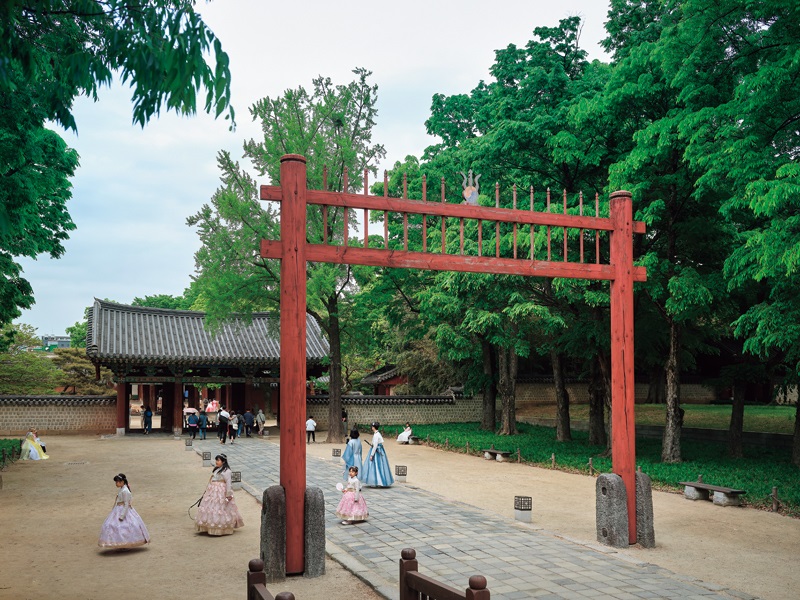
한복을 입고 경기전(慶基殿)을 산책 관람 중인 시민들. 경기전은 경기는 경사스러운(慶) 터전(基)이라는 뜻으로, 조선 왕조의 뿌리를 재확인하는 기념 장소 역할을 했다. Visitors donned in traditional Korean clothes at Gyeonggijeon, a shrine reaffirming the roots of the Joseon Dynasty; gyeonggi means “auspicious site.”
공간은 크게 세 영역으로 구성되어 있다. 정전(正殿)은 태조의 어진을 모셨던 곳으로, 경기전의 중심 영역이다. 현재 정전에 있는 어진은 모사본(模寫本)이고, 원본(原本)은 정전 뒤 어진박물관에 수장돼 있다. 정전 북쪽에 있는 조경묘(肇慶廟)는 태조의 22대조이자 가문의 시조인 이한(李翰) 부부의 위패를 봉안하려고 지은 건물이다. 그리고 그사이에 사고(史庫)가 있다. 『조선왕조실록(朝鮮王朝實錄)』이라는, 조선 건국 이래 자그마치 472년 동안의 역사를 매일 같이 수록한 책을 보관하기 위해 지은 건물이다. 한 왕조의 역사적 기록 중 세계에서 가장 긴 시간에 걸쳐 작성된 기록물로서, 왕조 시절의 원본이 그대로 남아 있는 세계 유일 사례다. 대한민국 국보이자 유네스코 세계기록유산이다.
Gyeonggijeon is divided into three sections. Jeongjeon is the main hall where a replica of Taejo’s portrait is enshrined. The original is stored in the Royal Portrait Museum behind the hall. Jogyeongmyo, the second section, is an ancestral shrine to the north of Jeongjeon, which was built to enshrine the memorial tablets of Yi Han and his wife. Yi was the founding father of the Jeonju Yi clan and progenitor of Taejo 22 generations back. The third section, the historical archive built to house the Annals of the Joseon Dynasty, lies between the two structures. The Annals contain daily accounts of the dynasty since its founding and constitute the longest historical record of any single dynasty in the world and the only case in which the original volumes remain intact. They have been designated as a national treasure of Korea and are inscribed in the UNESCO Memory of the World Register.
언뜻 비장해 보이는 공간이지만, ‘하마비(下馬碑)’와 ‘드므(순우리말. ‘頭毛’라 음차하기도 한다)’에서는 옛사람들의 위트가 엿보인다. 하마비는 ‘지위 고하를 막론하고 여기서부터는 하마, 즉 모두 말에서 내려 지나가라’라는 뜻에서 세운 비다. 경기전 정문 앞에 놓여 있는데, 비를 받치고 있는 두 마리의 사자(獅子) 또는 해치(獬豸) 모습에서 엄숙함보다 조선 석물 특유의 익살스러움이 묻어난다. 정전 뜰에 놓여있는 6개의 드므는 방화수를 담아뒀던 수조들이다. 행여 화마(火魔)가 건물 가까이 오더라도 물 표면에 반사된 자신의 흉측함에 놀라 도망가길 원하는 바람이 녹아 있다.
In front of the entrance to Gyeonggijeon is a stele that marks the spot where everyone, regardless of status, had to dismount from their horse. Propping it up are two stone statues of haechi, a legendary creature resembling a lion, that look playful rather than stern, as is characteristic of Joseon stone sculptures. Six large cast iron cauldrons in the courtyard of Jeongjeon held water to extinguish fires. They were also meant to repel fire demons, hoping they would be startled at the sight of their ghastly reflections in the water and flee. In an otherwise solemn space, these whimsical elements are evidence of the wit of Joseon-era Koreans.
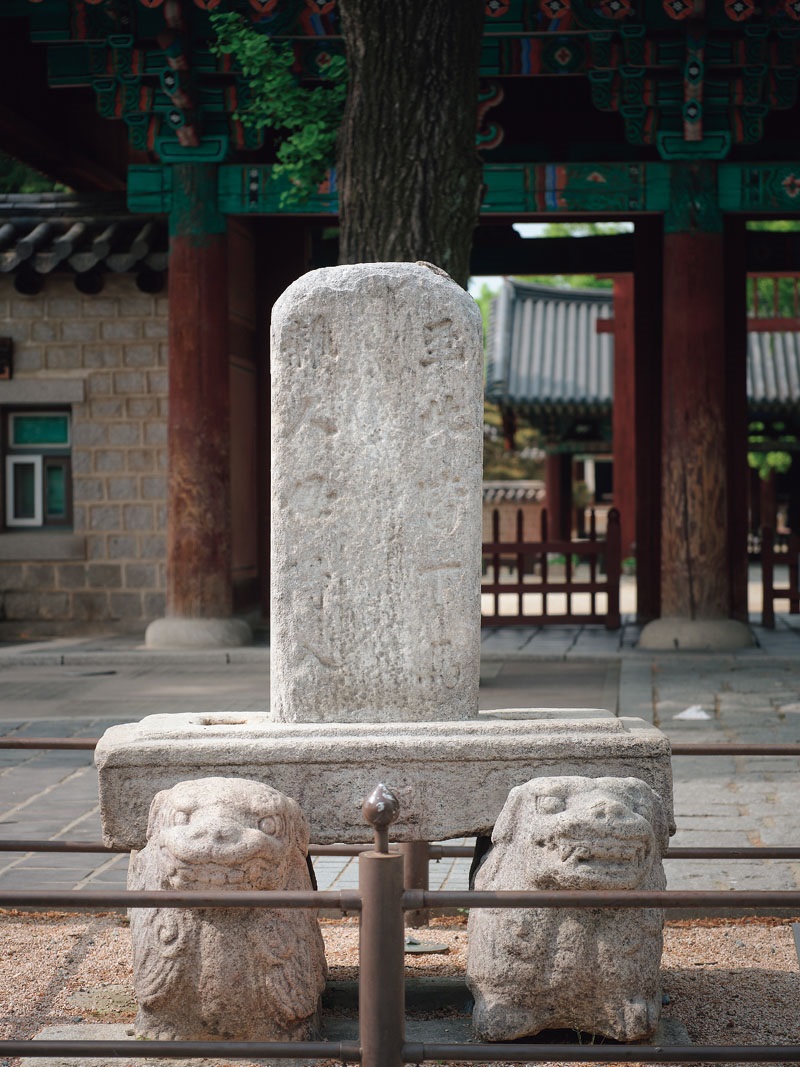
누구든 말에서 내려야 한다는 문구가 적혀있는 하마비 (下馬碑). A stele in front of the entrance to Gyeonggijeon marks the spot where everyone, regardless of status, had to dismount from their horse.
뿐만 아니라 500년에 가까운 조선왕조 내내 지금의 전북과 전남, 그리고 제주도 일대를 총괄하던 행정 관청이었던 전라감영(全羅監營), 전주부성(全州府城) 시설물 가운데 유일하게 남아 있는 풍남문(豐南門) 등은 오목대와 경기전, 그리고 한옥마을과 함께 전주의 역사와 전통, 나아가 위상을 상징하는 문화유산들이다.
Along with Omokdae, Gyeonggijeon, and the hanok village, other sites also reflect the history, tradition, and stature of Jeonju. These include Jeolla Gamyeong, the provincial governor’s office that oversaw the affairs of the present-day North and South Jeolla provinces as well as Jeju Island during the Joseon Dynasty, and Pungnammun, the south gate and only remnant of Jeonju Fortress that once encircled the city.
전통 속에 녹아있는 교류의 자취 - LEGACY OF EXCHANGES
전주에 오로지 수백 년 전의 옛것만 남아 있는 것은 아니다. 포용력을 바탕으로 하는 변화의 증거들도 적지 않다. People usually associate Jeonju with the Joseon Dynasty and Korean traditions, but it is more than just a city of relics dating back hundreds of years. A closer look reveals a legacy of exchanges with other countries and cultures that have shaped Jeonju’s contemporary identity.
경기전 바로 맞은편에 다소 이질적으로 보이는 건물이 우뚝 서있다. 전동성당(殿洞聖堂)이다. 한반도 최초의 순교(殉敎) 현장에 들어선 성당으로, 지난 1914년 완공되었다. 그런데 이 건물을 지은 주요 인부들은 조선인 혹은 한국인이 아니었다. 『전동성당 100년사』에 따르면, 성당 건축을 위해 중국인 목수 5명과 석공 100여 명이 가마를 설치해 65만 장의 벽돌을 찍어냈다고 한다. 그들을 이끈 인물은 강의관(姜義寬)이라는 이였는데, 쌍흥호(雙興號)라는 건축회사를 운영하며 다양한 천주교 관련 건물을 지은 것으로 알려져 있다. 전주라고 하면 으레 조선왕조와 전통이라는 키워드를 떠올리곤 하지만, 알고 보면 오랜 교류의 자취도 숨어있다.
Across from Gyeonggijeon, the Roman-Byzantine style Jeondong Cathedral stands tall. Completed in 1914, it was built on the site of the first Catholic martyrdom in Korea. Interestingly, many laborers who worked on the cathedral’s construction were not, in fact, Korean. According to 100-Year History of Jeondong Cathedral, more than 100 Chinese workers — five carpenters and some 100 stonemasons — built a kiln and baked 650,000 bricks. Their supervisor, Gang Ui-gwan, operated the architectural firm Ssangheungho and is known to have constructed various Catholic structures.
1914년 준공된 전주 전동성당(全州 殿洞聖堂)/ 로마네스크 양식이 돋보이는 건물로, 초기 천주교 성당중에서 그 규모가 크고 외관이 뛰어나게 아름답다. Completed in 1914, Jeondong Cathedral is a Roman-Byzantine style building that is among the largest of early Catholic churches in Asia.전주 하면 중국과의 교류도 빼놓을 수 없다. 중국인들이 전주에 정착하기 시작한 것은 지금으로부터 125년 전의 일이다. 1899년 전주에서 약 50킬로미터 거리에 있는 군산(群山)이 개항(開港)되며 ‘쿨리(苦力)’라 불렀던 인부를 비롯해 상인들이 들어오기 시작한 것이다. 그들 눈에 군산보다 상업과 문화, 행정 등 여러 방면에서 상위 도시였던 전주가 들어온 것은 당연한 일이었다. 그리고 점차 정착하는 이들이 많아졌고, 그들은 지금의 다가동(多佳洞) 차이나 거리를 중심으로 화교(華僑) 공동체를 일구어 나갔다.
The history of Chinese immigrants to Jeonju dates back to 1899, when the port of Gunsan opened 50 kilometers away. Merchants and laborers seeking to make a living put down roots in Jeonju, which was more advanced in terms of commerce, culture, and administration. Over time, a Chinese community formed that gave rise to the present-day Daga-dong Chinatown. Some of these immigrants were employed in the shipping or farming industries, but around 60 percent worked in the restaurant business or traded fabrics, such as silk and satin.
당시 화교들 중에는 해운업이나 농업에 종사하는 이들도 있었지만 60%에 달하는 이들은 요식업과 주단포목(紬緞布木)을 거래하는 상업에 종사한 것으로 알려져 있다. 오랜 전통의 도시에 화교의 유입에 따른 문화적 접변(接變)은 특히 요식업에 큰 영향을 미쳤다. ‘중화요리(中華料理)’라는 전에 없던 음식들이 한반도에 전래되기 시작한 것이다.
중화요리는 새 정착지의 식재료를 이용해 현지화되고, 이내 현지인의 입맛을 사로잡아 대중화의 길을 걷는 특성이 있다. 소스인 춘장(春醬)만 중국에서 왔을 뿐 지금은 한국식 중화요리의 대표주자가 된 ‘짜장면’이 대표적인 경우다. 전주 화교는 그 짜장면에 또 한 번 혁신을 가했다. ‘물짜장’이라는 새로운 음식으로 변주해 낸 것이다.
Acculturation brought on by the Chinese community in a city with a rich tradition had a particularly profound impact on the Korean palate. Chinese cuisine incorporating locally sourced ingredients gained widespread popularity. A case in point is jjajangmyeon, a Korean-Chinese noodle dish with black bean sauce. Taking it a step further, Chinese chefs in Jeonju d mul-jjajangmyeon, a variation using soy sauce to cater to Korean customers who may find black bean sauce too rich and oily. Starch is added to thicken the sauce, which is poured over boiled seafood and flour noodles. The result is a dish akin to assorted seafood noodle soup.
물짜장에는 춘장이 전혀 들어가지 않는다. 기름기 많은 짜장면을 부담스러워하는 한국 손님을 위해 춘장 대신 간장을 주축으로 삼았기 때문이다. 즉 간장 베이스에 전분을 넣어 걸쭉한 소스를 만든 뒤, 삶은 해물과 밀가루 면 위에 얹은 것이다. 원래의 짜장면과는 전혀 다르게 해물잡탕면에 가까운, 또 하나의 한국식 중화요리가 탄생하는 순간이었다.
Muljjajang contains no chunjang at all. Instead of the black bean paste, soy sauce is used as the base, which was preferred by Korean customers who found the original jjajangmyeon too greasy. The soy sauce is thickened with starch and poured over boiled seafood and wheat noodles. Thus, another Korean-style Chinese dish, more similar to a seafood stir-fry than the original jjajangmyeon, was born.
대히트를 친 물짜장은 멈춰 있지 않았다. 또다시 ‘순한맛’과 한국인이 좋아하는 ‘매운맛’으로 분화되어 갔다. 그러고는 이내 군산시(群山市)와 익산시(益山市), 완주군(完州郡) 등 인근 도시로도 번져나갔다. 전주에서는 전주화교소학교(全州華僑小學校) 교장이기도 한 화교 류영백(劉永伯) 씨가 운영하는 진미반점(真味飯店), 역시 오랜 역사를 자랑하는 대보장(大寶莊) 등이 물짜장 명맥을 잇고 있는 식당으로 정평이 나 있다.
Mul-jjajangmyeon became a huge hit and evolved further, with a spicy version d to suit Koreans’ predilection for heat. Two well-known restaurants in Jeonju carrying on the tradition of mul-jjajangmyeon are Jinmi Banjeom, run by Ryu Yeong-baek, an ethnic Chinese local who is also the principal of Jeonju Chinese Elementary School, and Daebojang, a family business which opened in 1962.
사실 화교의 유입은 전주뿐만 아니라 한반도 전체의 식문화를 진일보시키는 데 큰 도움을 주었다. 예를 들어 불고기나 갈비탕, 잡채, 심지어 순대에까지 들어가는 당면(唐麵) 등 다양한 식재료들이 화교들을 통해 들어왔다. 그리고 거기에 한국의 식재료와 요리법이 접목되면서 음식문화의 폭발적인 융성을 가져왔다.
Incidentally, culinary contributions by the Chinese community in Korea are not just seen in Jeonju but the entire country. Humble cellophane noodles, which originated in China, are a good example; they have become a key ingredient for bulgogi (barbequed beef), galbitang (short rib soup), japchae (stir-fried noodles with vegetables), and even sundae (Korean blood sausage). Jeonju has readily embraced numerous cultural influences; the city today is the sum of those interactions.
그런 면에서 이제는 화교와 전주, 화교와 한국을 굳이 구분해 생각하는 것은 큰 의미가 없을지도 모른다. 문화에는 위아래도, 내 것 네 것도 없기 때문이다. 어떤 문명이든 다른 문명을 다각적으로 받아들여 융합하는 과정에서 그간의 단점을 보완하고 장점을 극대화하며 발전을 도모해 왔을 뿐이다. 전주는 그와 같은 교류를 품어주는 품 너른 고장이었으며, 그런 교류의 결과가 곧 전주다.
태초부터 당연한 것도 없었다. 비빔밥 역시 그러하다. 그중에서도 고급스러운 색과 맛, 그리고 고소한 풍미가 일품인 전주비빔밥을 궁중음식에서 유래했다고 하는 경우가 있으나, 이는 사실과 다르다. 전주비빔밥이 이토록 인기를 얻게 된 데에도 지치지 않는 혁신의 노력이 있었다.
The city’s most famous dish, Jeonju bibimbap, is known for its aesthetically pleasing colors and sumptuous taste. Local chefs have continuously reinvented it, and the dish remains widely enjoyed today.
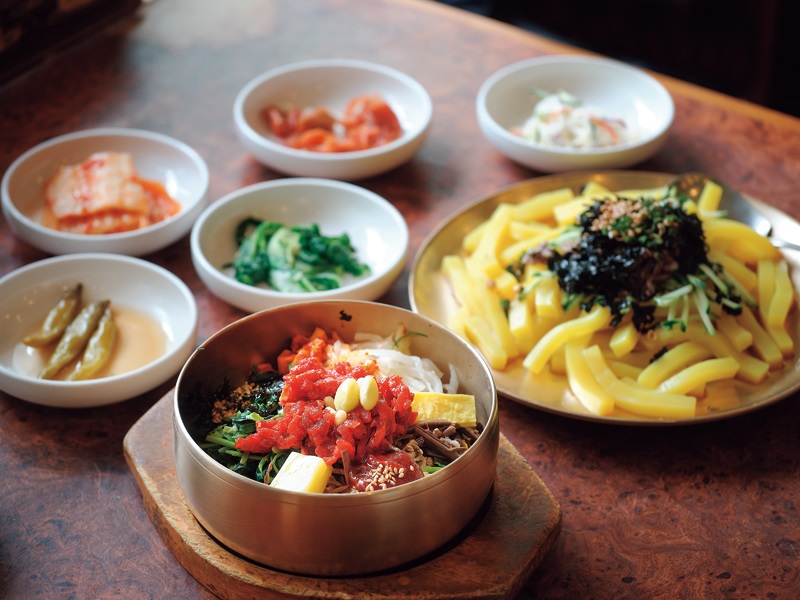
전주 향토 음식인 전주비빔밥은 전주는 물론 한국을 대표하는 음식이 되었다. 전주 비빔밥의 종류는 30여 가지로 계절에 따라 조금씩 달라진다. Jeonju bibimbap, a local specialty of the city, has become a dish representing Korea’s culinary tradition. There are over 30 varieties whose ingredients differ slightly depending on the season.
현재 전주에서 가장 오래된 전주비빔밥 식당은 1951년 문을 연 ‘한국집’이다. 다만 당시에는 비빔밥이 아니라 ‘한국떡집’이라는 상호를 내걸고 떡과 정과(正果)를 판매했다고 한다. 그 뒤 부가가치를 높이기 위해 식사 메뉴로 떡국을 팔기 시작했다. 문제는 당시에는 떡국이 주로 겨울에만 먹는 음식으로 인식되었다는 점이다. 그때 떠올린 것이 사철 장사가 가능한 ‘뱅뱅돌이’였다.
Jeonju’s oldest bibimbap restaurant is Han Kook Jib, which opened in 1951. In the early days, the business was called Hankook Tteokjip, and the owners sold rice cakes and jeonggwa, a traditional Korean confection. They later added tteokguk, rice cake soup, to the menu, but since the dish was mainly eaten in winter, they concocted baengbaengdori, which could be sold year-round.
뱅뱅돌이는 전주지역에서 비빔밥을 일컬었던 말로, 주걱이나 숟가락으로 뱅뱅 돌려가며 밥을 비비는 모습을 비유적으로 표현한 이름이다. 당시 시장에서는 대형 그릇에 온갖 나물을 넣어 한꺼번에 비빈 뒤, 손님 주문에 따라 1인분씩 덜어주는 방식이었다고 한다. 전주 역사에 조예가 깊은 한학자 고(故) 조병희(趙炳喜 1910~2003) 씨는 1988년에 전주문화원이 발간한 『전주풍물기 (全州風物記)』라는 책에 실은‘1920년대 남밖장’이라는 글에서 뱅뱅돌이에 대해 이렇게 썼다.
Baengbaengdori is the Jeonju name for bibimbap and describes the way the rice and various ingredients are mixed by stirring them in a circular motion with a spoon or rice paddle. It was once customary to first mix the cooked rice and assorted vegetables in a huge bowl before filling customers’ individual bowls. The late scholar Cho Byung-hee, an expert in Jeonju history, described baengbaengdori in his 1988 essay “Nambak Market in the 1920s.”
“음식점에 들르게 되면 건장한 일꾼이 커다란 양푼을 손에 받쳐 들고 옥 쥔 숟가락 두어 개로 비빔밥을 비벼 대는데, 흥이 나면 콧노래를 부르기도 하고, 빙빙 돌리던 양푼이 허공에 빙빙 돌다가 다시 손으로 받쳐 들고 비벼대는 솜씨는 남밖장만이 가지고 있는 정경이랄까?”
“When you go to a restaurant, you will see a worker with a sturdy build supporting a large brass bowl with one hand and adeptly mixing the bibimbap with two spoons held firmly in the other. They will hum a tune when in the mood, spin the bowl around in the air, then catch it with their hand. This kind of skill can only be witnessed at Nambakjang.”
남밖장은 전주부성의 남문, 즉 풍남문 밖에 있는 시장을 가리키는 말로, 지금은 전주남문시장이라 불린다. 낮 시간대 시장도 인상적이지만 매일 밤 열리는 야시장 때문에라도 여행자들의 성지로 일컬어지는 곳이다. 아무튼 남밖장의 이런 뱅뱅돌이를 콩나물과 고사리, 애호박, 표고버섯 같은 채소에 쑥부쟁이와 꽃버섯 등의 계철 채소, 그리고 쇠고기 육회를 얹는 식으로 고급스럽게 재해석해 낸 것이 바로 한국집이었다.
Nambakjang, short for Nammunbak Sijang, was the market outside the southern gate. It is now called Jeonju Nambu Market and impressive during the day, but the night market is the main attraction for tourists. Restaurants specializing in baengbaengdori are within a short radius of the market. They include Han Kook Jib, which invented an upscale version of the dish featuring bean sprouts, bracken fern, zucchini, shiitake, seasonal greens, aster, and cauliflower mushrooms as well as the highlight, beef tartare. The creation has inspired countless other bibimbap restaurants in Jeonju to invent their own interpretations.
현재 전주에 비빔밥 식당으로 한국집만 있는 것은 아니다. 은행과 밤, 대추 등 영양식 재료를 넣은 비빔밥을 돌솥에 담아내는 하숙영 가마솥비빔밥(전 중앙회관), 밥을 미리 초벌 볶음을 해서 내는 성미당 등도 사랑을 받고 있다. 1950년대초 한국집이 비빔밥을 고급화한 이래 셀 수 없이 많은 비빔밥 식당이 자신만의 변주와 혁신을 이어가며 1960~1970년대부터 이미 ‘비빔밥 골목’을 형성하기 시작한 곳이 전주다. 그래서일까? 지금은 전주 시민은 물론 전주를 찾는 거의 모든 여행자의 필수 방문지로 자리매김한 지 오래다. 심지어 2007년 이래 매년 가을이면 전주비빔밥축제도 열리고 있다.
While Ha Suk-yeong Gamasot Bibimbap, formerly known as Jungang Hoegwan, serves its bibimbap in a hot stone pot and adds nutritious ingredients, such as ginkgo nuts, chestnuts, and jujube, Seongmidang’s twist includes pre-frying the rice before serving it. Bibimbap Alley, near Nambu Market, has long been a popular spot among Jeonju citizens as well as a must-visit destination for tourists. The location, which began to flourish in the 1960s, has played host to the Jeonju Bibimbap Festival every fall since 2007.
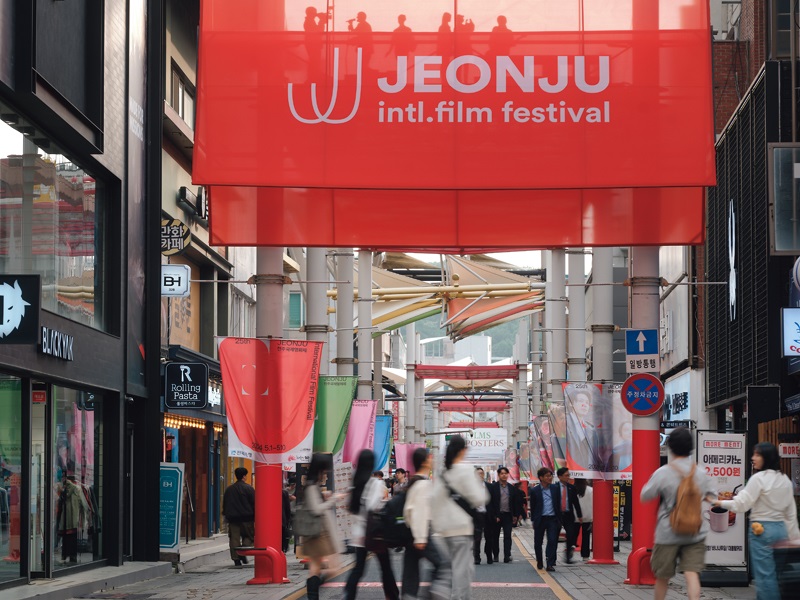
지난 5월 영화의 거리를 비롯해 전주 곳곳에서 진행된 제25회 전주국제영화제. 10일간 총 43개국 232편의 영화가 상영됐다. The 25th JEONJU International Film Festival in May was celebrated across the city, including at Film Street, a 10–15 minute stroll from Jeonju Hanok Village. A total of 232 films from 43 countries were screened over ten days.
당연한 풍경 너머의 새로운 발견 - TRADITIONS AND INCLUSIVITY
전주에 가면 한국의 어제와 오늘을 한 눈에 확인할 수 있다. 500년에 가까운 시간 동안 여러 모순을 극복하며 지탱해 온 조선왕조의 기반에서부터 인적 물적 교류를 통해 더욱 풍성한 문화를 살찌워온 역사, 그리고 전통에 기반을 두되 한순간도 안주하지 않고 변주에 변주, 혁신에 혁신을 거듭하며 발전해 온 한국 사회의 저변을 만날 수 있다.
Jeonju is a city where you can encounter traces of Korea’s past and various facets of its present, from the foundation of the Joseon Dynasty and enriching exchanges with other countries to today’s tireless efforts to innovate and evolve while also upholding tradition. Jeonju has a relaxed pace and offers a harmonious blend of nature and culture.
2010년 인구 50만 이상의 대도시 가운데 세계 최초로 국제슬로시티로 지정된 연유, 2012년 세계에서 4번째로 유네스코 음식창의도시로 선정된 비밀도 바로 거기에 숨어 있다. 다시 말하건대 전주는 역사와 전통을 단순히 ‘답습’하는 것이 아니라 포용성을 바탕으로 발전적으로 ‘계승’해야 하는 이유를 일깨워주는 여행지이다.
In 2010, it became the first large Korean city with a population of over 500,000 to earn a designation as a Slow City by Cittaslow International. Two years later, Jeonju was named the fourth UNESCO Creative City of Gastronomy in recognition of its efforts to protect traditional food culture and develop the gastronomy sector. Jeonju is a travel destination that reminds us why we should continue to reinterpret and build on history and traditions based on inclusivity, rather than simply reproducing them.
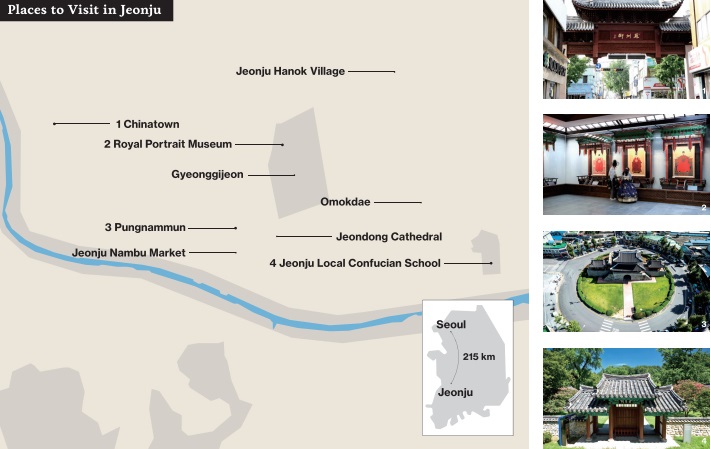
사진 © 한국관광공사 - Korea Tourism Organization
권기봉(KWON Ki-bong 權奇鳯) 작가
이민희(Lee Min-hee 李民熙) 사진작가
Kwon Ki-bong Writer
Lee Min-hee Photographer
%20%EB%A1%9C%EB%A7%88%EB%84%A4%EC%8A%A4%ED%81%AC%20%EC%96%91%EC%8B%9D%EC%9D%B4%20%EB%8F%8B%EB%B3%B4%EC%9D%B4%EB%8A%94%20%EA%B1%B4%EB%AC%BC%EB%A1%9C,%20%EC%B4%88%EA%B8%B0%20%EC%B2%9C%EC%A3%BC%EA%B5%90%20%EC%84%B1%EB%8B%B9%EC%A4%91%EC%97%90%EC%84%9C%20%EA%B7%B8%20%EA%B7%9C%EB%AA%A8%EA%B0%80%20%ED%81%AC%EA%B3%A0%20%EC%99%B8%EA%B4%80%EC%9D%B4%20%EB%9B%B0%EC%96%B4%EB%82%98%EA%B2%8C%20%EC%95%84%EB%A6%84%EB%8B%B5%EB%8B%A4.jpg)
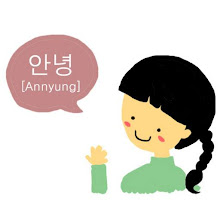


.jpg)





0 comments: